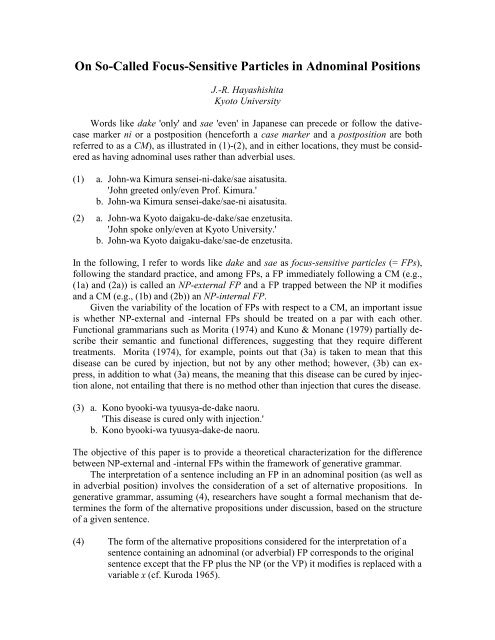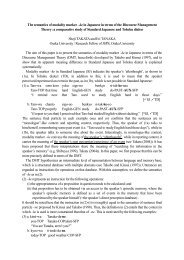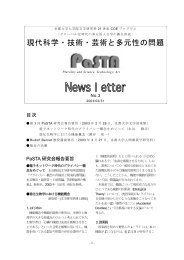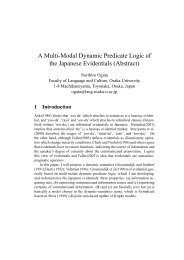On So-Called Focus-Sensitive Particles in Adnominal Positions
On So-Called Focus-Sensitive Particles in Adnominal Positions
On So-Called Focus-Sensitive Particles in Adnominal Positions
Create successful ePaper yourself
Turn your PDF publications into a flip-book with our unique Google optimized e-Paper software.
<strong>On</strong> <strong>So</strong>-<strong>Called</strong> <strong>Focus</strong>-<strong>Sensitive</strong> <strong>Particles</strong> <strong>in</strong> Adnom<strong>in</strong>al <strong>Positions</strong><br />
J.-R. Hayashishita<br />
Kyoto University<br />
Words like dake 'only' and sae 'even' <strong>in</strong> Japanese can precede or follow the dativecase<br />
marker ni or a postposition (henceforth a case marker and a postposition are both<br />
referred to as a CM), as illustrated <strong>in</strong> (1)-(2), and <strong>in</strong> either locations, they must be considered<br />
as hav<strong>in</strong>g adnom<strong>in</strong>al uses rather than adverbial uses.<br />
(1) a. John-wa Kimura sensei-ni-dake/sae aisatusita.<br />
'John greeted only/even Prof. Kimura.'<br />
b. John-wa Kimura sensei-dake/sae-ni aisatusita.<br />
(2) a. John-wa Kyoto daigaku-de-dake/sae enzetusita.<br />
'John spoke only/even at Kyoto University.'<br />
b. John-wa Kyoto daigaku-dake/sae-de enzetusita.<br />
In the follow<strong>in</strong>g, I refer to words like dake and sae as focus-sensitive particles (= FPs),<br />
follow<strong>in</strong>g the standard practice, and among FPs, a FP immediately follow<strong>in</strong>g a CM (e.g.,<br />
(1a) and (2a)) is called an NP-external FP and a FP trapped between the NP it modifies<br />
and a CM (e.g., (1b) and (2b)) an NP-<strong>in</strong>ternal FP.<br />
Given the variability of the location of FPs with respect to a CM, an important issue<br />
is whether NP-external and -<strong>in</strong>ternal FPs should be treated on a par with each other.<br />
Functional grammarians such as Morita (1974) and Kuno & Monane (1979) partially describe<br />
their semantic and functional differences, suggest<strong>in</strong>g that they require different<br />
treatments. Morita (1974), for example, po<strong>in</strong>ts out that (3a) is taken to mean that this<br />
disease can be cured by <strong>in</strong>jection, but not by any other method; however, (3b) can express,<br />
<strong>in</strong> addition to what (3a) means, the mean<strong>in</strong>g that this disease can be cured by <strong>in</strong>jection<br />
alone, not entail<strong>in</strong>g that there is no method other than <strong>in</strong>jection that cures the disease.<br />
(3) a. Kono byooki-wa tyuusya-de-dake naoru.<br />
'This disease is cured only with <strong>in</strong>jection.'<br />
b. Kono byooki-wa tyuusya-dake-de naoru.<br />
The objective of this paper is to provide a theoretical characterization for the difference<br />
between NP-external and -<strong>in</strong>ternal FPs with<strong>in</strong> the framework of generative grammar.<br />
The <strong>in</strong>terpretation of a sentence <strong>in</strong>clud<strong>in</strong>g an FP <strong>in</strong> an adnom<strong>in</strong>al position (as well as<br />
<strong>in</strong> adverbial position) <strong>in</strong>volves the consideration of a set of alternative propositions. In<br />
generative grammar, assum<strong>in</strong>g (4), researchers have sought a formal mechanism that determ<strong>in</strong>es<br />
the form of the alternative propositions under discussion, based on the structure<br />
of a given sentence.<br />
(4) The form of the alternative propositions considered for the <strong>in</strong>terpretation of a<br />
sentence conta<strong>in</strong><strong>in</strong>g an adnom<strong>in</strong>al (or adverbial) FP corresponds to the orig<strong>in</strong>al<br />
sentence except that the FP plus the NP (or the VP) it modifies is replaced with a<br />
variable x (cf. Kuroda 1965).
There are two major approaches. <strong>On</strong>e treats an FP plus the NP it modifies as a generalized<br />
quantifier (cf. von Stechow 1991) (henceforth the GQ analysis). The other is<br />
based on the alternative semantics developed <strong>in</strong> Rooth 1985, which makes crucial reference<br />
to focus (henceforth the Roothian analysis). These approaches are dist<strong>in</strong>guished as<br />
follows. The GQ analysis must assume an FP plus the NP it modifies to obligatorily undergo<br />
quantifier rais<strong>in</strong>g <strong>in</strong> May 1977 while the Roothian analysis need not. Conversely,<br />
the Roothian analysis must add the focus feature to the feature <strong>in</strong>ventory while the GQ<br />
analysis need not.<br />
This paper argues that (A) the GQ analysis is desirable for NP-external FPs while the<br />
Roothian analysis is not, and that (B) neither the GQ analysis nor the Roothian analysis<br />
can be adopted for NP-<strong>in</strong>ternal FPs. In support of (A) (and a part of (B)), I demonstrate<br />
that an NP-external FP with the NP it modifies behaves exactly <strong>in</strong> the same way as quantifiers<br />
that can reasonably be assumed to obligatorily undergo quantifier rais<strong>in</strong>g do; however,<br />
an NP-<strong>in</strong>ternal FP with the NP it modifies cannot be so considered. For example,<br />
given that the embedded scope read<strong>in</strong>g <strong>in</strong> (6a) is <strong>in</strong>felicitous, as opposed to the matrix<br />
scope read<strong>in</strong>g <strong>in</strong> (6b), the contrast <strong>in</strong> (5) is considered as <strong>in</strong>dicat<strong>in</strong>g that the scope of<br />
kimi-ni-dake 'you-CM-only' is clause-bounded, resembl<strong>in</strong>g the behavior of relevant quantifiers,<br />
while that of kimi-dake-ni 'you-only-CM' is not.<br />
(5) a. #Boku-wa kimi-ni-dake meguriau tameni umaretekita.<br />
'I was born to meet you.'<br />
b. Boku-wa kimi-dake-ni meguriau tameni umaretekita.<br />
(6) a. #I was born so that I meet no one other than you.<br />
b. There is no one other than you that I was born to meet (i.e., my birth is for you!)<br />
It is also shown that sentences with an NP-external FP cannot be considered as <strong>in</strong>volv<strong>in</strong>g<br />
focus unlike the cases of those with an NP-<strong>in</strong>ternal FP, further confirm<strong>in</strong>g (A).<br />
To ma<strong>in</strong>ta<strong>in</strong> (B), I question that the fundamental assumption <strong>in</strong> (4), adopted both by<br />
the GQ analysis and by the Roothian analysis, holds for sentences <strong>in</strong>clud<strong>in</strong>g an NP<strong>in</strong>ternal<br />
FP. For example, while the <strong>in</strong>terpretation of (7a), a case of NP-external FP, <strong>in</strong>volves<br />
the consideration of a set of propositions whose form is that John raised a question<br />
to x after the class, that of (7b), a case of NP-<strong>in</strong>ternal FP, cannot unless zyuugyoo-no<br />
ato 'after the class' is de-accented. When the phonological control is absent <strong>in</strong> (7b),<br />
probably the default way of read<strong>in</strong>g, the form of the relevant alternative propositions is<br />
that John raised a question to x, contrary to (4). Hav<strong>in</strong>g ma<strong>in</strong>ta<strong>in</strong>ed (B), the paper then<br />
proposes a new analysis for NP-<strong>in</strong>ternal FPs, mak<strong>in</strong>g reference to pragmatics.<br />
(7) a. John-wa Kimura sensei-ni-dake zyugyoo-no atode situmonsita.<br />
'John raised a question only to Prof. Kimura after the class.'<br />
b. John-wa Kimura sensei-dake-ni zyugyoo-no atode situmonsita.<br />
<strong>On</strong>e significant implication of this paper is that for the study of LF structural properties,<br />
NP-external FPs are useful while NP-<strong>in</strong>ternal FPs are not. This work thus suggests<br />
that works address<strong>in</strong>g LF properties without dist<strong>in</strong>guish<strong>in</strong>g between NP-external and -<br />
<strong>in</strong>ternal FPs <strong>in</strong> Japanese l<strong>in</strong>guistics be re-evaluated.
Selected References:<br />
Kuroda, S.-Y. 1965. Generative Grammatical Studies <strong>in</strong> the Japanese Language. Doctoral dissertation,<br />
MIT.<br />
Morita, Y. 1971. The Usage of -dake and –bakari. Bullet<strong>in</strong> of the Institute of Language Teach<strong>in</strong>g<br />
10: 1-27, Tokyo: Waseda Univserity.<br />
Rooth, M. 1985. Association with <strong>Focus</strong>, Doctoral dissertation, University of Massachusetts.<br />
von Stechow, A. 1991. Current Issues <strong>in</strong> the Theory of <strong>Focus</strong>, Semantics- An International<br />
Handbook of Contemporary Research, eds. A. von Stechow and D. Wunderlich, 804-825 de





